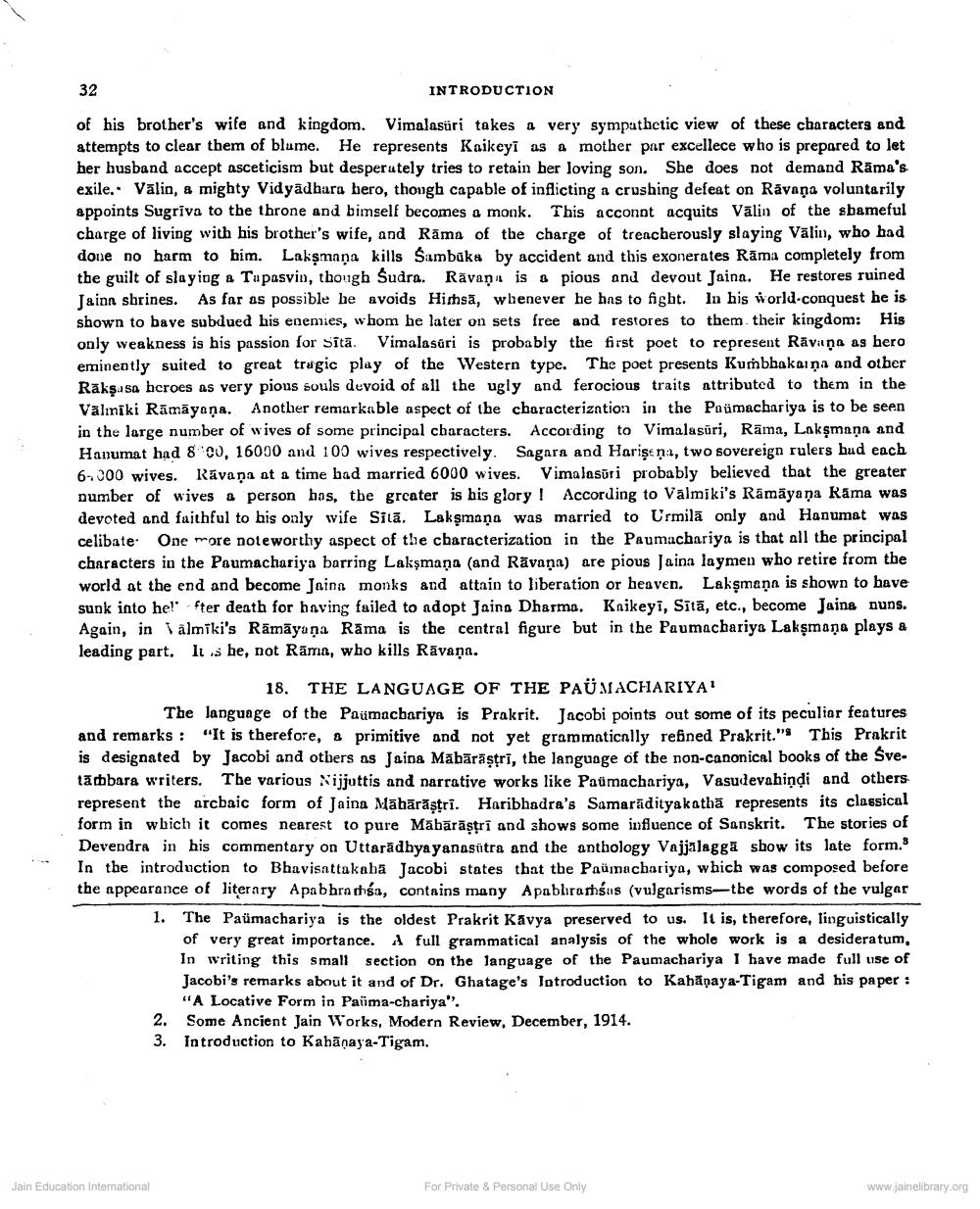________________
32
INTRODUCTION
of his brother's wife and kingdom. Vimalasüri takes a very sympathetic view of these characters and attempts to clear them of blume. He represents Kaikeyī as a mother par excellece who is prepared to let her husband accept asceticism but desperately tries to retain her loving son. She does not demand Rama's exile. Välin, a mighty Vidyadhara hero, though capable of inflicting a crushing defeat on Rāvana voluntarily appoints Sugrīva to the throne and himself becomes a monk. This acconnt acquits Valin of the shameful charge of living with his brother's wife, and Rama of the charge of treacherously slaying Valin, who had done no harm to him. Lakṣmaṇa kills Sambūka by accident and this exonerates Rama completely from the guilt of slaying a Tapasvin, though Sudra. Ravana is a pious and devout Jaina. He restores ruined Jaina shrines. As far as possible he avoids Himhsa, whenever he has to fight. In his world-conquest he is shown to bave subdued his enemies, whom he later on sets free and restores to them their kingdom: His only weakness is his passion for Sītā. Vimalasuri is probably the first poet to represent Ravana as hero eminently suited to great tragic play of the Western type. The poet presents Kumbhakaina and other Raksasa heroes as very pious souls devoid of all the ugly and ferocious traits attributed to them in the Valmiki Rāmāyaṇa. Another remarkable aspect of the characterization in the Paümachariya is to be seen in the large number of wives of some principal characters. According to Vimalasūri, Rāma, Lakṣmaṇa and Hanumat had 800, 16000 and 100 wives respectively. Sagara and Harisena, two sovereign rulers hud each 6.000 wives. Ravana at a time had married 6000 wives. Vimalasuri probably believed that the greater number of wives a person has, the greater is his glory! According to Valmiki's Rāmāyaṇa Rāma was devoted and faithful to his only wife Sita. Lakṣmaṇa was married to Urmila only and Hanumat was celibate One more noteworthy aspect of the characterization in the Paumachariya is that all the principal characters in the Paumachariya barring Laksmana (and Ravana) are pious Jaina laymen who retire from the world at the end and become Jaina monks and attain to liberation or heaven. Laksmana is shown to have sunk into helfter death for having failed to adopt Jaina Dharma. Kaikeyi, Sitä, etc., become Jaina nuns. Again, in Valmiki's Rāmāyaṇa Rāma is the central figure but in the Paumachariya Lakṣmaṇa plays a leading part. Its he, not Rama, who kills Rāvana.
18. THE LANGUAGE OF THE PAUMACHARIYA'
The language of the Paumachariya is Prakrit. Jacobi points out some of its peculiar features and remarks: "It is therefore, a primitive and not yet grammatically refined Prakrit." This Prakrit is designated by Jacobi and others as Jaina Mābārāṣṭri, the language of the non-canonical books of the Svetäthbara writers. The various Nijjuttis and narrative works like Paumachariya, Vasudevahindi and others represent the archaic form of Jaina Mahārāṣṭrī. Haribhadra's Samaradityakatha represents its classical form in which it comes nearest to pure Mahārāṣṭri and shows some influence of Sanskrit. The stories of Devendra in his commentary on Uttaradhyayanasutra and the anthology Vajjalagga show its late form. In the introduction to Bhavisattakaha Jacobi states that the Paumachariya, which was composed before the appearance of literary Apabhrathsa, contains many Apabhramhsus (vulgarisms-the words of the vulgar
Jain Education International
1. The Paümachariya is the oldest Prakrit Kavya preserved to us. It is, therefore, linguistically of very great importance. A full grammatical analysis of the whole work is a desideratum. In writing this small section on the language of the Paumachariya I have made full use of Jacobi's remarks about it and of Dr. Ghatage's Introduction to Kahanaya-Tigam and his paper : "A Locative Form in Pauma-chariya".
2. Some Ancient Jain Works, Modern Review, December, 1914.
3. Introduction to Kahaṇaya-Tigam.
For Private & Personal Use Only
www.jainelibrary.org




